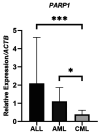Association of PARP1 Expression Levels and Clinical Parameters in Different Leukemic Subtypes With BCR::ABL1 p190+ Translocation
- PMID: 39238631
- PMCID: PMC11372699
- DOI: 10.21873/cdp.10368
Association of PARP1 Expression Levels and Clinical Parameters in Different Leukemic Subtypes With BCR::ABL1 p190+ Translocation
Abstract
Background/aim: Although the reciprocal translocation t(9;22)(q34;q11) is a hallmark of chronic myeloid leukemia (CML), it is also present in acute lymphoblastic leukemia (ALL) and acute myeloid leukemia (AML). Depending on the gene's breakpoint, it is possible to obtain three isoforms, among which p190 stands out for the poor prognosis it induces whenever it appears. Due to the genomic instability induced by BCR::ABL1, it is proposed to expand the applicability of poly-ADP-ribose polymerase-1 (PARP1) and its inhibitors in hematological neoplasms.
Materials and methods: We measured the expression levels of PARP1 by quantitative real-time PCR (qPCR) using TaqMan®, correlating its expression with BCR::ABL1 p190+, to evaluate its influence in the clinic of adult patients.
Results: We found that PARP1 is expressed differently in ALL, AML and CML and that p190 transcripts do not follow a linear pattern in these populations. We also found that PARP1 expression is not correlated with age, white blood cell and the amount of p190 transcripts.
Conclusion: Despite the lack of statistical correlation between the variables analyzed, the role of PARP1 in BCR::ABL1 leukemia cannot be ruled out, given the instability profile promoted by this translocation. Finally, further studies involving a larger sample of patients are needed, as well as investigations into other molecular pathways that may impact on the pathogenesis of different BCR::ABL1 leukemic subtypes.
Keywords: BCR::ABL; Biomarker; PARP polymerase; hematological malignancies.
©2024 The Author(s). Published by the International Institute of Anticancer Research.
Conflict of interest statement
The Authors declare no conflicts of interest regarding this study.
Figures

Similar articles
-
PARP1 Characterization as a Potential Biomarker for BCR::ABL1 p190+ Acute Lymphoblastic Leukemia.Cancers (Basel). 2023 Nov 22;15(23):5510. doi: 10.3390/cancers15235510. Cancers (Basel). 2023. PMID: 38067214 Free PMC article.
-
A rare BCR-ABL1 transcript in Philadelphia-positive acute myeloid leukemia: case report and literature review.BMC Cancer. 2019 Jan 10;19(1):50. doi: 10.1186/s12885-019-5265-5. BMC Cancer. 2019. PMID: 30630459 Free PMC article. Review.
-
Acute monocytic leukemia with coexpression of minor BCR-ABL1 and PICALM-MLLT10 fusion genes along with overexpression of HOXA9.Genes Chromosomes Cancer. 2006 Jun;45(6):575-82. doi: 10.1002/gcc.20320. Genes Chromosomes Cancer. 2006. PMID: 16518848
-
Molecular and Clinical Insights in the Increasing Detection of BCR::ABL1 p190+ in Adult Acute Myeloid Leukemia Patients.In Vivo. 2024 Jul-Aug;38(4):2016-2023. doi: 10.21873/invivo.13659. In Vivo. 2024. PMID: 38936913 Free PMC article.
-
Philadelphia Chromosome-Positive Leukemia in the Lymphoid Lineage-Similarities and Differences with the Myeloid Lineage and Specific Vulnerabilities.Int J Mol Sci. 2020 Aug 12;21(16):5776. doi: 10.3390/ijms21165776. Int J Mol Sci. 2020. PMID: 32806528 Free PMC article. Review.
References
-
- Rashid K, Hassan A, Tanvir I, Ehsan K. Significance of Philadelphia chromosome in chronic myeloid leukemia patients of Anmol Hospital, Lahore, Pakistan. Pakistan Biomed J. 2018;1(1) doi: 10.52229/pbmj.v1i1.47. - DOI
-
- Döhner H, Wei AH, Appelbaum FR, Craddock C, Dinardo CD, Dombret H, Ebert BL, Fenaux P, Godley LA, Hasserjian RP, Larson RA, Levine RL, Miyazaki Y, Niederwieser D, Ossenkoppele G, Röllig C, Sierra J, Stein EM, Tallman MS, Tien H, Wang J, Wierzbowska A, Löwenberg B. Diagnosis and management of AML in adults: 2022 recommendations from an international expert panel on behalf of the ELN. Blood. 2022;140(12):1345–1377. doi: 10.1182/blood.2022016867. - DOI - PubMed
LinkOut - more resources
Full Text Sources
Miscellaneous
